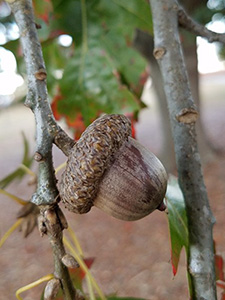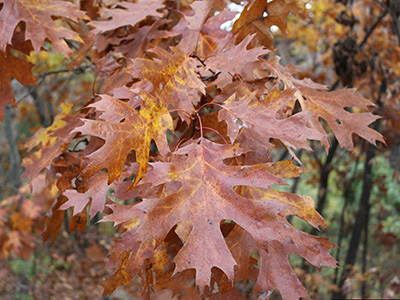Shumard Oak
This native tree offers shade in the summer and a burst of rich color in fall.

Shumard oak (Quercus shumardii) is an ideal tree for urban landscapes, including both home yards and commercial settings. It’s often seen in parking lot islands, since it copes well with air pollution, poor drainage, drought and compacted soils. It’s also a popular choice for providing shade in parks and large yards.
Many gardeners appreciate Shumard oak for its interesting foliage. It features traditional oak-shaped leaves that are dark green throughout most of the year. Then in fall and winter, the 4- to 8-inch leaves turn a brilliant red or red-orange before falling to the ground.
It makes a lovely shade tree, thanks to its broad, open crown that gets more rounded as the tree gets older. Once mature, trees can reach 80 feet tall and have a canopy of 40 to 50 feet wide.
Shumard oak also boasts some of the largest acorns of all Florida oaks, with each acorn reaching up to 1.5 inches wide. Wildlife like squirrels, deer and turkey love to feed on the acorns, and some people enjoy using them in craft projects and holiday decor. The tree produces acorns every 2-5 years starting at age 25.
In the spring, Shumard oaks grow both male and female flowers on the same tree. The blooms are inconspicuous and wind-pollinated, which is common among oaks. The male flowers are long, slender yellow-green catkins responsible for producing pollen. The female flowers are much smaller and reddish; they capture pollen and create seeds.
The Shumard oak can live quite a long time, averaging well over one hundred years and up to 480 years old! In Florida, it grows wild throughout the Panhandle and across North Florida southward to Marion County. It’s wildlife-friendly, serving as a habitat and nesting area for many species of mammals and birds. It is also the host plant for the larvae of numerous moth and butterfly species, such as the imperial moth (Eacles imperialis) and the juvenal’s duskywing (Erynnis juvenalis).
Planting and Care
This native tree is found growing across the eastern United States and is hardy in zones 5b-9b. Shumard oak can be grown in full sun in acidic, neutral or alkaline soil. It will grow best in a soil that’s rich and moist, though it can also be planted in drier sites. Established trees tend to be drought tolerant, though they may drop their leaves during extended droughts.
Before planting your Shumard oak, dig a hole that’s at least 1.5 times wider than the diameter of the root ball and slightly shallower. Ultimately the top of the root ball should be 1 to 2 inches higher than the surrounding soil once the tree is planted.
Use a sharp knife or a shovel to shave off the periphery of the root ball before placing it into the hole. Fill in around the root ball with soil, packing it in firmly with your foot. Then water the tree well to help remove any air voids in the soil.
Spread a layer of mulch 3-4 inches deep around the tree but do not cover the root ball area. Follow a regular watering schedule for the first year; for every inch of the tree trunk’s diameter, you should apply 2 gallons of water to the root ball, two to three times a week.
As a rule, this resilient tree is generally free from pests and serious diseases. Mites and root rot on wet soil are the major pests, while scales, aphids, borers, caterpillars, lace bugs and leaf miners can also affect the tree.
Like other oaks, Shumard oak needs to be pruned strategically when it’s young to help the tree develop a strong branch structure.
This native tree is valued for its flashy fall foliage and extra-large acorns that attract many animals. Shumard oak could become a treasured tree in your landscape, providing shade for many years to come. For more information on Shumard oak, contact your county Extension office.


